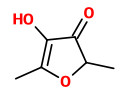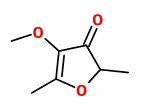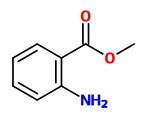Dies ist eine alte Version des Dokuments!
Fragaria ×ananassa Duchesne ex Rozier - Rosaceae - (garden) strawberry, Garten-Erdbeere
„The fruit (which is not a botanical berry, but an aggregate accessory fruit) is widely appreciated for its characteristic aroma, bright red color, juicy texture, and sweetness. “
http://en.wikipedia.org/wiki/Garden_strawberry
Of the 24 aroma compounds found in Senga Sengana strawberries, the most important compounds were ethyl butanoate, ethyl hexanoate and 2,5-dimethyl-4-hydroxy-3(2H)-furanone.
[Odour thresholds of some important aroma compounds in strawberries., Larsen, M., Poll, L., Zeitschrift für Lebensmittel-Untersuchung und Forschung, 195(2), 1992, 120-123]
„2,5-Dimethyl-4-hydroxy-3(2H)-furanone, linalool and ethyl hexanoate were found to be important general strawberry aroma compounds whereas ethyl butanoate, methyl butanoate, γ-decalactone and 2-heptanone were found to be important cultivar-specific aroma compounds.“
[Evaluation of the aroma composition of some strawberry (Fragaria ananassa Duch) cultivars by use of odour threshold values., Larsen, M., Poll, L., Olsen, C.E., Zeitschrift für Lebensmittel-Untersuchung und Forschung, 195(6), 1992, 536-539]
Dark red overripe strawberries contained up to 37mg/kg furaneol (cult. Oso Grande), up to 23.5mg/kg mesifuran (cult. I-101), and also furaneol glucoside up to 12-13mg/kg.
[Furanones in strawberries: evolution during ripening and postharvest shelf life., Pérez, A. G., Olías, R., Sanz, C., Olías, J.M., Journal of Agricultural and Food Chemistry, 44(11), 1996, 3620-3624]
 4-hydroxy-2,5-dimethyl-3(2H)-furanone (DHF, HDMF, furaneol) |  4-methoxy-2,5-dimethyl-3(2H)-furanone (DMF, mesifuran) |  methyl anthranilate |  γ-decalactone |
„Strawberry aroma types… A very important role is played by methylanthranilate, which is responsible for the typical character of the wood strawberry (Fr. vesca L.) aroma, which is characterized by an intensive spicy-aromatic and flowery note. All genotypes investigated can be subdivided into a methylanthranilate-containing and methylanthranilate-free types. As well as some wild species, [the Fragaria × ananassa variety] Mieze Schindler is a methylanthranilate-containing type. For decades this old cultivar has been known as one of the most favoured strawberries in Germany. Depending on climatic conditions “Mieze Schindler” contains low to medium concentrations of methylanthranilate. In contrast, the methylanthranilate-free group is divided in a sensorially pleasant group (ester-type) and a less pleasant group (DHF-type). Fr. virginiana L. - one of the parental genotype of Fr. ananassa Duch., with a fresh and fruity aroma - can be assigned to the ester-type. The third group, the DHF-type, contains varieties with medium to poor flavour…“
[Analysis of strawberry flavour-discrimination of aroma types by quantification of volatile compounds., Ulrich, D., Hoberg, E., Rapp, A., Kecke, S., Zeitschrift für Lebensmitteluntersuchung und-Forschung A, 205(3), 1997, 218-223]
„Twelve odorants, previously identified with high flavor dilution (FD) factors, were quantified in a fresh strawberry juice by using stable isotope dilution assays. Calculation of odor activity values (ratio of concentration to odor threshold), on the basis of odor thresholds in water, revealed especially the six compounds (Z)-3-hexenal (green), 4-hydroxy-2,5-dimethyl-3(2H)-furanone (caramel-like, sweet), methyl butanoate (fruity), ethyl butanoate (fruity), methyl 2-methylpropanoate (fruity), and 2,3-butanedione (buttery) as the key flavor compounds in the typical strawberry-like odor of the juice. These results were corroborated by the following sensory experiments: A mixture of the 12 most potent odorants added to a model juice matrix, consisting of pectin, sugars, and nonvolatile acids, in concentrations equal to those in the fresh juice, resulted in an overall odor profile very similar to that of the fresh juice. Furthermore, comparison of the overall odors of 11 model mixtures lacking in 1 of the 12 odorants under investigation, with the odor evoked by the complete set of odorants, showed a clear flavor difference, especially when 4-hydroxy-2,5-dimethyl-3(2H)-furanone, (Z)-3-hexenal, or methyl butanoate was lacking in the mixture.“
[Evaluation of the Character Impact Odorants in Fresh Strawberry Juice by Quantitative Measurements and Sensory Studies on Model Mixtures. P. Schieberle, T. Hofmann, Journal of Agricultural and Food Chemistry, 1997, 45(1)]
„The (−)-enantiomer of 2,5-dimethyl-4-hydroxy-(2H)-furan-3-one (DMHF) and the S-enantiomer of linalool were tentatively identified as the predominant forms in both the cultivars Selva and Adina. The compounds benzaldehyde and methyl hexanoate were shown to decrease in post-harvest berries, whilst DMHF and nerolidol increased upon storage.“
[Analysis of strawberry volatiles using comprehensive two-dimensional gas chromatography with headspace solid-phase microextraction. Angela Williams, Danielle Ryan, Alexandra Olarte Guasca, Philip Marriott, Eddie Pang, Journal of Chromatography B, Volume 817, Issue 1, 5 March 2005, 97-107]
„Esters are known to be important contributors to typical strawberry aroma (Gomes da Silva and Chaves das
Neves, 1999; Larsen and Poll, 1992; Perez et al., 1992; Schieberle and Hofmann, 1997). Among them, methyl and
ethyl butanoates, methyl and ethyl hexanoates, and ethyl 2-methyl butanoate are often mentioned as active aroma compounds in strawberry. Furanones (furaneol and mesifurane) are also contributors to aroma providing sweet caramel-like notes(Larsen and Poll, 1992; Perez et al., 1996; Sanz et al., 1994). Additionally, aldehydes and alcohols such as n-hexanal, (Z)-3-hexenal, and (E)-2-hexenal are responsible for green and pungent notes (Schieberle and Hofmann, 1997; Schulbach et al., 2004).“
[A Sensory and Chemical Analysis of Fresh Strawberries Over Harvest Dates and Seasons Reveals Factors That Affect Eating Quality. Celine Jouquand, Craig Chandler. J. Amer.Soc.Hort.Sci. 133(6):859–867. 2008] http://journal.ashspublications.org/content/133/6/859.full.pdf
Solid phase extraction was acknowledged as the method of choice for the extraction of furaneol and mesifuran out of a strawberry matrix. Furaneol (17.4-30.7 mg/kg) and mesifuran (4.7-7.3 mg/kg) concentrations of different strawberries varieties were determined by this method.
[Furaneol and mesifuran in strawberries–an analytical challenge., Siegmund, B., Bagdonaite, K., Leitner, E., Expression of multidisciplinary flavour science, 2010, 537-540] https://home.zhaw.ch/~yere/pdf/Teil134%20-%20Expression%20of%20Multidisciplinary.pdf
„γ-Decalactone is a reliable chiral indicator in the stereoselective analysis of fresh strawberry flavour. The enantiomeric purity of the (R)-(+)-enantiomer in 11 strawberry fruit cultivars was 90-100%.“
[Ravid, Uzi, et al. „Authenticity assessment of natural fruit flavour compounds in foods and beverages by auto‐HS-SPME stereoselective GC-MS.“ Flavour and fragrance journal 25.1 (2010): 20-27]
The major odor active volatiles in both cultivars, ‘Strawberry Festival’ and ‘Florida Radiance’ (winter-grown strawberries, harvested in February and March), were 2,5-dimethyl-4-methoxy-3(2H)-furanone (DMMF), 2,5-dimethyl-4-hydroxy-3(2H)-furanone (DMHF), methyl butanoate, γ-decalactone, unknown (grassy, LRI 1362, wax), (E)-2-hexenal, linalool, (E,Z)-2,6-nonadienal, geraniol, butanoic acid, methyl 2-methylbutanoate, and ethyl hexanoate. „The highest OAVs for ‘Strawberry Festival’ were ethyl butanoate (461), DMHF (424), methyl butanoate (358), and linalool (102)… Sensory “strawberry flavor” scores were positively correlated with sensory “sweetness” (R2 = 0.83) as well as GC-MS methyl 3-methylbutanoate (R2 = 0.90) and ethyl butanoate (R2 = 0.96). These cultivars lacked methyl anthranilate and possessed an aroma pattern different from summer-grown strawberries.“
[Du, Xiaofen, et al. „Evaluation of volatiles from two subtropical strawberry cultivars using GC-olfactometry, GC-MS odor activity values, and sensory analysis.“ Journal of agricultural and food chemistry 59.23 (2011): 12569-12577]
„Analysis of the aroma value (the ratio of compound concentration to odor threshold) has indicated that less than 20 compounds contribute significantly to strawberry flavor (Schieberle and Hofmann, 1997; Ulrich et al., 1997; Jetti et al., 2007). Esters, formed by esterification of alcohols and acyl-CoA, constitute the largest and one of the most important groups contributing to the aroma of strawberry fruit (Pérez et al., 1992, 2002). Among them, ethyl 2-methylbutanoate, ethyl and methyl butanoates, ethyl and methyl hexanoates, and hexyl and (E)-2-hexenyl acetates have been reported as key aroma compounds for strawberry fruit, providing green and sweet fruity notes (Schieberle and Hofmann, 1997; Pérez et al., 2002; Ménager et al., 2004). Terpenes, which include linalool, nerolidol, terpineol, or α-pinene, constitute the other important group, providing pleasant citrus and spicy notes and reaching up to 20% of total fruit volatiles in some cultivars of strawberry (Loughrin and Kasperbauer, 2002). Other compounds considered important for strawberry flavor are hexanal, (Z)-3-hexenal, 2-heptanone, and γ-decalactone, the latter being a noteworthy cultivar-specific compound conferring peach (Prunus persica)-like flavor to strawberry fruit (Larsen and Poll, 1992; Larsen et al., 1992; Schieberle and Hofmann, 1997; Ulrich et al., 1997). Yet the two most important contributors to strawberry aroma are furanones and most specifically 2,5-dimethyl-4-hydroxy-3(2H)-furanone (DMHF or furaneol) and 2,5-dimethyl-4-methoxy-3(2H)-furanone (DMMF or mesifurane; Pyysalo et al., 1979; Larsen and Poll, 1992; Pérez et al., 1996; Raab et al., 2006). Furaneol imparts caramel and sweet notes at high concentrations and fruity notes at lower concentrations, whereas mesifurane has been described as having a more burnt, sherry-like, or fusty aroma (Larsen and Poll, 1992; Pérez et al., 1996).“
[Genetic analysis of strawberry fruit aroma and identification of O-methyltransferase FaOMT as the locus controlling natural variation in mesifurane content., Zorrilla-Fontanesi, Y., Rambla, J.L., Cabeza, A., Medina, J.J., Sánchez-Sevilla, J.F., Valpuesta, V., Amaya, I., Plant physiology, 159(2), 2012, 851-870]
http://www.ncbi.nlm.nih.gov/pmc/articles/PMC3375946/
„The last step in the biosynthetic route to the key strawberry flavor compound 4-hydroxy-2,5-dimethyl-3(2H)-furanone (HDMF) is catalyzed by Fragaria x ananassa enone oxidoreductase (FaEO), earlier putatively assigned as quinone oxidoreductase (FaQR). The ripening-induced enzyme catalyzes the reduction of the exocyclic double bond of the highly reactive precursor 4-hydroxy-5-methyl-2-methylene-3(2H)-furanone (HMMF) in a NAD(P)H-dependent manner.“ Ripe strawberry fruits contain up to 50mg/kg HDMF.
[Structural basis for the enzymatic formation of the key strawberry flavor compound 4-hydroxy-2,5-dimethyl-3(2H)-furanone. Schiefner A1, Sinz Q, Neumaier I, Schwab W, Skerra A., J Biol Chem. 2013 Jun 7;288(23):16815-26] http://www.ncbi.nlm.nih.gov/pmc/articles/PMC3675614/
[Die molekularen Grundlagen des Erdbeeraromas, Wilfried Schwab, André Schiefner, 2013] http://www.analytik-news.de/Fachartikel/Volltext/tu_muenchen3.pdf
„The classes and concentrations of volatile organic compounds (VOC) released from fresh and decaying strawberries were investigated and compared… four ester compounds, ethyl butyrate, ethyl hexanoate, ethyl isovalerate, and ethyl 2-methylbutyrate were identified as the key constituents of fresh strawberry aroma. As the strawberries began to decay, isobutyl alcohol recorded the maximum OAV of 114.“
[Quantitative analysis of fragrance and odorants released from fresh and decaying strawberries., Kim, Y. H., Kim, K. H., Szulejko, J. E., Parker, D., Sensors, Vol.13(6), 2013, 7939-7978] http://www.mdpi.com/1424-8220/13/6/7939/htm
„Of the forty-six volatile compounds cited as relevant to strawberry flavor in five studies only seven are mutual to at least three of the studies, exemplifying the lack of agreement in defining flavor-relevant constituents. This consensus includes butanoic acid, methyl ester; butanoic acid, ethyl ester; hexanoic acid, methyl ester (106-70-7); hexanoic acid, ethyl ester; linalool; butanoic acid, 2-methyl- (116-53-0); and 3(2H)-furanone, 4-methoxy-2,5-dimethyl-, all of which are quantified in this report.
These compounds exhibit adequate variability in fruit samples to discern dose dependent effect on flavor intensity. However, only linalool; butanoic acid, ethyl ester; butanoic acid, methyl ester; and
3(2H)-furanone, 4-methoxy-2,5-dimethyl- show significant positive correlation with flavor intensity… Over one third of volatiles in this study significantly correlate with strawberry flavor intensity, potentially enhancing perception of a complex and highly variable volatile mixture, seventeen of which are not of previous strawberry flavor focus. Two of these unrecognized compounds, 1-hexanol (111-71-7) and butanoic acid, 3-methyl-, butyl ester (109-19-3), are present in the most flavorful strawberry sample but undetected in the least flavorful. This pair of compounds as well as pentanoic acid, ethyl ester (539-82-2) and butanoic acid, 3-methyl-, octyl ester (7786-58-5), also present/absent in the most/least flavorful, have relatively minor amounts but show evidence of enhancing perceived sweetness intensity independent of individual sugars.“
[Strawberry Flavor: Diverse Chemical Compositions, a Seasonal Influence, and Effects on Sensory Perception. Michael L. Schwieterman et al., PLoS One. 2014; 9(2): e88446. Published online Feb 11, 2014] http://www.ncbi.nlm.nih.gov/pmc/articles/PMC3921181/
Of the 43 compounds measured as aroma-active in an extract of Fragaria ×ananassa 'Ciflorette', nine were perceived by all 7 panelists: butyric acid (cheesy fruity), ethyl butyrate (estery fruity sweet), dimethyl sulfoxide (sulfurous rotten garlic), 2-methylthio-ethanol (alliaceous, burnt onion), (E)-2-hexenal (fruity green leafy), 3-mercaptohexanal (green, passion fruit, pungent), 4-hydroxy-2,5-dimethyl-3(2H)-furanone (sweet candy caramellic), (E)-beta-damascenone (sweet fruity), and methyl N-methylanthranilate (fruity sweet). The overall sensorial impression of Ciflorette strawberries is unique, compared to other strawberry varieties. Described in nature for the first time were 1-(methylthio)-2,3-butanedione (aroma-active, sulfurous), 3-(acetylthio)-hexanal (not aroma-active) , and 2,6-dipropyl-3-formyl-5,6-dihydro-2H-thiopyran (not aroma-active, green mango tropical).
[In‐depth analysis of Ciflorette strawberries (Fragaria× ananassa ‘Ciflorette’) by multidimensional gas chromatography and gas chromatography‐olfactometry., Cannon, R. J., Agyemang, D., Curto, N. L., Yusuf, A., Chen, M.Z., Janczuk, A.J., Flavour and Fragrance Journal, 30(4), 2015, 302-319]
Grassy, fruity, sweet and spicy are the aroma descriptors of strawberry vinegars using the modified frequency (MF) technique. Ethyl 2-methylbutyrate, mesifurane, β-damascenone, furaneol and γ-decalactone were preserved during the double fermentation process of the strawberry substrate.
„… a total of 12 odour zones, identified as acetic, butyric and isovaleric acids, methional, 3-nonen-2-one, 2-phenylethanol, pantolactone + furaneol, p-vinylguaiacol, sotolon, phenylacetic acid and vanillin, were considered as possible impact odorants of strawberry vinegars. Finally, all potential impact odorants with similar sensory descriptors were grouped into eight categories, these being: fruity, sweet, grassy, spicy, butter–lactic–cheesy, chemical, empyreumatic and miscellaneous.“
[Ubeda, C., Callejon, R. M., Troncoso, A. M., Moreno‐Rojas, J. M., Peña, F., Morales, M. L.; Characterization of odour active compounds in strawberry vinegars. Flavour and fragrance journal, 27(4), 2012, 313-321]

Bessler,Basilius, Hortus Eystettensis, vol.1: Septimus ordu Collectarum plantarum vernalium, t.119, fig. I (1620) [B.Besler]
http://plantgenera.org/species.php?id_species=443098

strawberry flowers, CC BY-SA 3.0, Author: Andreas Kraska
